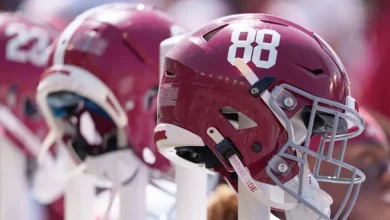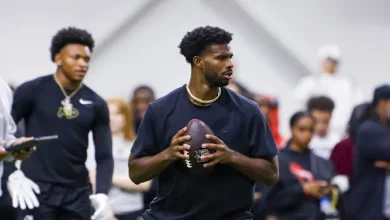Nate Oats, the head coach of Alabama, attributes the Tigers’ defeat to Auburn’s defensive strategy.

When the Alabama Crimson Tide took on the Auburn Tigers in what was billed as one of the most significant matchups of the SEC season, expectations were sky-high. Alabama, led by head coach Nate Oats, had been riding high on the strength of a potent offense that could light up the scoreboard and take down almost any opponent. Auburn, under the leadership of head coach Bruce Pearl, had quietly built a strong team, one known for its suffocating defense and unrelenting hustle. What transpired on the court was a stunning 94-85 victory for Auburn, and one that shook the SEC landscape to its core.
Following the loss, Nate Oats did not mince words in his postgame analysis. He was clear about what he believed was the primary reason for Alabama’s defeat—Auburn’s defensive strategy. As the game unfolded, it became evident that Auburn’s defense was the defining factor in limiting Alabama’s high-powered offense, and Oats was quick to give credit to Pearl and his defensive game plan. But while Oats was quick to acknowledge the challenge presented by Auburn’s defense, he also pointed to areas where his own team needed to improve if they were to remain a championship contender.
In this article, we’ll dive deeper into what Oats had to say following the game, how Auburn’s defensive strategy was effective in disrupting Alabama’s offensive flow, and what this loss means for both teams moving forward in the SEC and NCAA Tournament race.
Nate Oats’ Reflection: “Auburn’s Defense Gave Us Fits”
In his postgame comments, Oats was straightforward and candid about the struggles his team faced in the loss to Auburn. While he acknowledged the quality of Auburn’s play and their overall success, he didn’t shy away from identifying what he felt had been the key factor in his team’s defeat: Auburn’s defense.
“Auburn’s defense gave us fits all night long,” Oats said during his press conference. “They did a really good job of taking us out of what we wanted to do offensively. We’re a team that thrives on pace and three-point shooting, but Auburn really disrupted that. They’ve got length and athleticism, and they’re tough to get through when they’re locked in.”
The essence of Oats’ frustration lay in Auburn’s ability to force Alabama out of their rhythm and impose their defensive will. Alabama had come into the game as one of the most potent offensive teams in the country, led by explosive guard play and a fast-paced, three-point-heavy style. Alabama relies heavily on its ability to create open looks from beyond the arc, and when those shots are falling, the Tide can quickly build insurmountable leads. But against Auburn, Alabama’s offensive rhythm was consistently broken, and they were unable to establish their usual up-tempo pace.
Auburn’s defense, which has been one of the team’s calling cards under Bruce Pearl, was suffocating. The Tigers closed out on shooters quickly, forced Alabama into contested shots, and disrupted the Tide’s usual offensive flow with physicality and precision. Oats expressed admiration for the way Auburn’s defense was able to adjust, saying, “They don’t just rely on one defensive set. They mix things up, they pressure the ball, they switch when they need to, and they’re just relentless.”
Auburn’s Defensive Strategy: Disrupting Alabama’s Strengths
What Auburn did to Alabama’s offense was not just about individual players stepping up. It was about a well-executed, team-oriented defensive strategy that made it difficult for Alabama to do what they do best: shoot the three-ball and play at breakneck speed.
Auburn’s defensive game plan was multifaceted. First and foremost, they focused on limiting Alabama’s three-point attempts. The Tide’s offense is built around the three-point shot, and if Alabama can get going from deep, they become nearly impossible to defend. However, Auburn’s defense denied open looks from beyond the arc, contesting every shot and forcing Alabama to work for every point. The Tigers also did a fantastic job of closing down driving lanes, preventing Alabama’s guards from getting into the paint and collapsing the defense.
The second key aspect of Auburn’s defense was their ability to apply pressure on the ball handler. Alabama’s point guards, who usually control the pace of the game and create open looks, found themselves under constant duress from Auburn’s defenders. Whether it was trapping on ball screens, closing down passing lanes, or forcing turnovers, Auburn’s defensive effort had a clear impact on Alabama’s ability to run their offense efficiently.
As the game progressed, it was clear that Auburn’s defense was dictating the terms of engagement. Alabama, known for their ability to spread the floor and generate quick shots, was forced to slow down and work through sets that were outside of their comfort zone. “We couldn’t get into our flow,” Oats said. “They’re just too good defensively, and we couldn’t get the ball movement that we wanted. That’s a credit to them.”
Alabama’s Struggles: An Offense Out of Sync
While Auburn’s defense certainly played a major role in Alabama’s struggles, Oats also acknowledged that his team didn’t do themselves any favors with some poor execution. Alabama, especially early in the game, seemed to lack the urgency and focus needed to overcome Auburn’s defensive pressure.
Alabama’s offensive attack relies heavily on its ability to shoot the three-pointer and get out in transition. However, when Auburn disrupted those elements, Alabama’s offense seemed to sputter. Their shooters, usually so consistent, were unable to get into a rhythm. Alabama shot only 28.6% from three-point range, a far cry from their usual standard. When their perimeter shots weren’t falling, Alabama didn’t have enough of a backup plan. The Tide was unable to adjust, and Auburn took full advantage.
Part of the issue stemmed from Alabama’s inability to execute on the inside. When the three-point shot isn’t falling, Alabama tends to attack the basket, but Auburn’s defense was solid in the paint, contesting shots and forcing Alabama to either take tough looks or kick the ball back out to the perimeter. Oats noted that Alabama’s inability to create easy baskets inside or in transition was a major factor in the loss. “When we’re not getting the open shots we usually do, we need to be able to adjust,” he said. “That’s something we have to do better moving forward.”
Auburn’s Defensive Prowess: A Blueprint for Success
One of the key takeaways from Auburn’s victory over Alabama is that the Tigers’ defense is not only effective but adaptable. Coach Bruce Pearl has built a system that can adjust to different offensive styles and exploit weaknesses. Against Alabama, Auburn’s defensive game plan worked to perfection, forcing the Crimson Tide to play outside their strengths and preventing them from getting comfortable.
Auburn’s defense is built on pressure, length, and versatility. The Tigers have multiple defenders who can switch on screens, contest shots, and disrupt passing lanes. They have a deep rotation of players who can stay fresh and maintain a high level of intensity, and that depth allows them to wear teams down over the course of the game. Against a team like Alabama, whose offense thrives on open shots and fast breaks, Auburn’s defensive ability to slow down the pace and take away easy opportunities was crucial.
ESPN analysts were quick to point out that Auburn’s defensive strategy was a blueprint that other teams would look to replicate when facing Alabama. “If you can take away the three-point shot and disrupt Alabama’s flow, you’re going to give yourself a chance to win,” one analyst said during the broadcast. This is something that Oats and his staff will need to address as they prepare for the rest of the season.
What This Means for Both Teams Moving Forward
For Alabama, this loss to Auburn represents a crucial learning experience. Oats’ acknowledgment of Auburn’s defensive prowess is a sign of respect, but it also signals that Alabama will need to evolve offensively. The Tide cannot rely solely on their three-point shooting to carry them through tough games. They’ll need to develop a more well-rounded offensive approach, one that can work when the three-pointer isn’t falling. Additionally, Alabama will need to tighten up their defense to avoid being overwhelmed by teams with the offensive depth and defensive versatility that Auburn showcased.
On the other hand, Auburn’s victory solidifies their place among the SEC’s elite teams. With Bruce Pearl at the helm and a roster that boasts both defensive and offensive depth, Auburn is a team that no one should take lightly. Their ability to adjust to different teams and exploit weaknesses makes them a legitimate contender, not just in the SEC but nationally. As Auburn prepares for the remainder of the season, they’ll know that they have the tools to compete with anyone, and their defense will continue to be a huge part of their success.
A Valuable Lesson for Alabama
Ultimately, Nate Oats’ reflections on Auburn’s defensive strategy provide valuable insights into why Alabama struggled in this matchup. Auburn’s defensive game plan was well-executed and relentless, forcing Alabama out of their comfort zone and exploiting their weaknesses. For Alabama, the loss serves as a reminder that offensive firepower alone is not enough to secure victories in the high-stakes environment of college basketball.
As Alabama prepares for the remainder of the season, they’ll need to take these lessons to heart. They must find ways to adapt when their shooting isn’t on point, and they must also work on improving their defense. Meanwhile, Auburn has established itself as a serious contender, with a defensive game plan that could carry them deep into the NCAA Tournament.









